 |
The 8th Gen Riviera Resource
|
| | | Brake Cooling Options |  |
| | | Author | Message |
|---|
AA
Administrator

Name : Aaron
Age : 46
Location : C-bus, Ohio
Joined : 2007-01-13
Post Count : 18448
Merit : 252
 |  Subject: Brake Cooling Options Subject: Brake Cooling Options  Wed Jan 11, 2012 7:30 pm Wed Jan 11, 2012 7:30 pm | |
| Last October, when I ran the Riv at Nelson Ledges, I confirmed something we already know: brakes get really hot after multiple high speed stops. What I didn't know then was how hot the brakes (F-Body) could get without permanent damage. After inspection, everything looked okay for the most part, pad wear was even, and so far the brakes have functioned very well for more than 3k miles since the track day. There was one small area that needed attention: the lower caliper slide pin boots for the front wheels were partially worn from hot gases/brake dust exiting the caliper. The boots have lasted 3 years so far, and can be replaced in a few minutes. Cost is about $3-5. If the biggest concern were replacing the caliper slide boots, I would be more than willing to do so after every race. It's really a non-issue, much less work & cost than replacing pads for instance. But there was a point after 8 or so laps where I started to feel the brakes' responsiveness change. It wasn't a total loss of braking, and it wasn't all-out fade, but it felt temperature induced. There was some light judder and a bit of squealing that I normally don't experience with the EBC BlueStuff pads. After a quick cool-down, all was back to normal. I still don't exactly know which part of the system started to give out, but I suspect it was the pads reaching their limit. So what to do? One option, and maybe the simplest, is to use a race track pad compound. I tried this option briefly last year, and saw more brake dust and rotor wear than I knew possible. That might be fine for a track day, but not for everyday use. But is there a way to keep high-performance street pads on the car for both street and track? It's a good question, and I believe the answer is 'yes'. There are plenty of newer cars demonstrating this ability. Two ways they do this are: bigger brakes and/or better brake cooling. Imo, big brakes are one of the reasons we see many cars getting bigger wheels from the factory in recent years. When fitting 6-piston Brembos and 14-inch discs under the front wheels, they need the extra room. Cars with such set-ups can actually go on track and safely do several high-speed laps per session. However, most customers buy these cars not for road racing, but because they like the look of larger rims and big brakes, probably assuming they do make the car stop better. Imo, that's not really true, unless you are driving illegally on the street. Big brakes are a very functional (and pricey) add-on that many drivers will never actually use to their full potential, but they do look cool, and they require the larger wheels. If you're already spending $40k+ on a sport sedan, why not splurge on the big brake package? This begs the question: why don't purpose-built race cars have 19" rims with big brakes? I think because the cars are lighter, and they used forced air to cool the brakes. Some production sports cars also have cooling ducts, but this is a specialized feature that in most cases must be designed into each car. It's not as easy as bolting on a larger rotor and changing calipers, which is another reason you see big brakes/wheels more often. Big brake kits actually use mostly off-the-shelf parts, with the brackets being the only specialized item. Because you're adding mass and quality materials to deal with the heat, it's almost guaranteed to be an improvement (but sometimes, as in the case of the NISMO 370Z, even big brakes aren't enough). Cooling ducts, on the other hand, require a bit of R&D up front, then some specially molded parts to fit the application. Steering clearance is a concern, and if necessary the control arms, steering knuckle, or the caliper may need to be redesigned. Even the body styling is impacted by the intake/exit locations. Being that I've already invested in the F-Body calipers, and I really do like their performance, I want to keep them if possible. If cooling ducts/scoops are possible to fit, I think they are be a solution to consider before upgrading to a larger and more expensive big brake kit. Examples of some brake cooling ideas on other cars: Conventional hose ducted through splash shield: 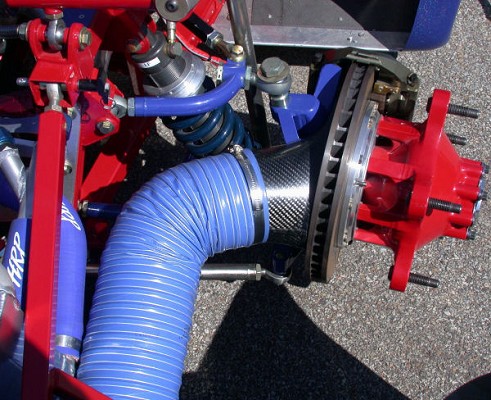 Scoop mounted to control arm:  Air "diverter" use on some Porsches:  I would imagine the true ducted hose system would involve some serious work and customization. Not sure I really need that. The scoop idea is pretty clever. I could build something similar. Same with the deflector, although I'm not sure how effective it would be. If it worked, something like this could be easily bolted to the control arm without removing the wheels. First step is to measure brake caliper temperatures to get a better idea of how hot the calipers actually get, and how quickly they cool down while driving. To do this, I found a cheap thermometer with 36" wired probe. It reads from -50º to 1300º (claims Celsius, but I'm calling BS): 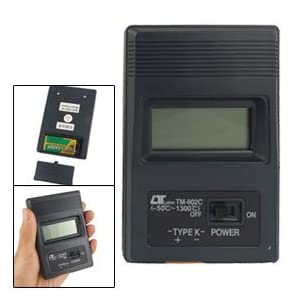 The plan is to attach the probe to the caliper, then route the gauge to the interior, or to another location where it can be monitored, and later compared to time, speed, decel, etc. It's only $12, so whether or not I decide to actual build a brake cooling duct system, I still have a high temp thermometer and hopefully will learn something about how hot the brakes get. Stay tuned... _________________ '05 GTO 6.0L • 6-spd • 95k miles • 0-60: 4.8s • 16.9 avg MPG • Nelson Ledges Lap: 1:26'95 Celica GT 2.2L • 5-spd • 165k miles • 0-60: yes'98 SC Riviera • 281k miles • 298 HP/370 TQ • 0-60: 5.79s • ET: 13.97 @ 99.28 • 4087 lb • 20.1 avg MPG • Nelson Ledges Lap: 1:30
3.4" pulley • AL104 plugs • 180º t-stat • FWI w/K&N • 1.9:1 rockers • OR pushrods • LS6 valve springs • SLP headers • ZZP fuel rails
KYB GR2 struts • MaxAir shocks • Addco sway bars • UMI bushings • GM STB • Enkei 18" EV5s w/ Dunlop DZ101s • F-body calipers
EBC bluestuff/Hawk HP plus • SS lines • Brembo slotted discs • DHP tuned • Aeroforce • Hidden Hitch^^^ SOLD ^^^  '70 Ninety-Eight Holiday Coupe 455cid • 116k miles '70 Ninety-Eight Holiday Coupe 455cid • 116k miles^^^ SOLD ^^^ 
Last edited by AA on Thu Jan 12, 2012 12:22 am; edited 3 times in total | |
|   | | Mr.Riviera
Expert

Name : Matthew
Age : 37
Location : Florida
Joined : 2007-01-17
Post Count : 4394
Merit : 101
 |  Subject: Re: Brake Cooling Options Subject: Re: Brake Cooling Options  Wed Jan 11, 2012 8:36 pm Wed Jan 11, 2012 8:36 pm | |
| I too have gotten my NDX pads really hot and found their performance decreased, not full-on fade like with a stock pad, but enough to know they needed to cool down.
But i cant say for sure it was the pad compound.
I seem to recall you using blue brake fluid, what is the wet and dry boiling point of the fluid? Seems to me the fluid at the piston would reach pretty extreme temps if a race pad is close to fade.
One other thing that concerns me with the f-body's in race conditions is caliper flex. I have noticed the pad deposit seems to form evenly across the rotor under normal driving but if i stop really hard from speed several times i notice the grey/blue deposit layer on only a ~70% center section of the rotor contact area.
While the pads have always worn evenly i believe the caliper is flexing and i am loosing some of the even force on the edge of the pads. It would seem the pads would then get hot spots and feel almost faded.
I did just order a brand new set of NDX pads and EBC slotted rotors so i will see if this set gives the same results.
BTW the 2nd picture isnt working. (teamspeed.com) _________________ 1996 with 254k miles, L32 4" FWI -> ported N* -> Ported Gen V w/3.0" Pulley, Stage 3 Phenolic I/C, ZZP FMHE, 1.84 RR, Headers and 3" pipe to mufflers, F-body brakes, and lowered on Eibachs. -RIP AMG C400 White on black. Stage 2 w/E30 - 11.9@117 -daily 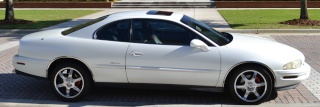 | |
|   | | Rivillac
Enthusiast

Name : Kevin
Location : NC
Joined : 2011-06-06
Post Count : 102
Merit : 13
 |  Subject: Re: Brake Cooling Options Subject: Re: Brake Cooling Options  Wed Jan 11, 2012 10:28 pm Wed Jan 11, 2012 10:28 pm | |
| http://www.cvproducts.com/ProdDet.aspx?PN=DRP007-10115
Here is an example of a spindle mounted caliper duct similar to what I have used before, though not on a street car. It would be fairly simple to fab up something similar this, and customize it as needed for steering clearance and suspension travel.
If you are looking for something quick and simple, I have seen a short length of 3" duct hose pointed to open air on one end and pointed into the inside of the rotor on the other. It's a little more forgiving as far as not being catastrophic if it rubs a tire. Similar to the second photo except without the plastic intake duct. Kinda hard to describe, but I'll see if I can round up a picture tomorrow. It's not show quality but it's functional. | |
|   | | AA
Administrator

Name : Aaron
Age : 46
Location : C-bus, Ohio
Joined : 2007-01-13
Post Count : 18448
Merit : 252
 |  Subject: Re: Brake Cooling Options Subject: Re: Brake Cooling Options  Thu Jan 12, 2012 12:18 am Thu Jan 12, 2012 12:18 am | |
| I still use the ATE Super Blue fluid; in my wife's car, too. It's good stuff. The OEM DOT 3 fluid has a dry (new) boiling point of 401F, and wet (old) boiling point of 284F. The Super Blue DOT 4 has a dry boil point of 536F, wet point is 392F. So even aged Super Blue is almost as good as brand new OEM. There's no comparison.
It should be obvious if you ever managed to boil the fluid. The pedal sinks to the floor, since boiling results in compressible gas in the line. If you feel fade with the pedal still firm, it's the pad compound reaching its limit. I've been able to experience pad fade with the HPS and HP+ compounds. I have not able to push the EBC BlueStuff to that point. I'd like to keep it that way without having to upgrade to new brakes, if possible.
The main drawback to floating type calipers is tapered wear of the pads. We saw this on our LeMons Integra over a 2-year period, though it wasn't too severe. The characteristic causes the inside of the pad to wear faster than the outside. So far, I've never seen this on any of my F-Body pads. Your pics of the used EBCs looked very even to me. I think you see it more when the pads are worn hot most of the time, as on a track. During normal street driving, they might even out.
I've experienced the type of "inner" deposit you're describing, but not sure how caliper flex would cause it. My opinion is that heat is focused most in the central area of pad/rotor contact. That's where the compound begins to liquify first, so you see it smear in that area. I would bet if you got on the brakes a whole lot, making them really hot for a period of time, you would see the deposit area widen across the rotor surface. Whatever the case, if you aren't seeing tapered wear, and you're getting enough force to lock up the wheels, is there really any problem?
Regarding the cooling experiment, I still have my old control arms in the garage, so it should make fabrication easier. Can't wait for the thermometer to arrive so I can start learning about what's happening, then fab up a few test mules to see of it's possible to shed the heat.
Rivillac, I've seen those spindle shrouds before, and have thought about making one. I once spent 15 minutes under the car looking for a place to access the inner area of the rotor. It's tough with FWD because there's a giant axle with CV boots in the way, and also the caliper is mounted forward, which gets in the way. Plus, the tie rod is behind the axle, which seems to be the complete opposite the way many race cars are built. From what I could see, there's a tiny slit between the caliper and knuckle where some air could be directed. There's an area 180º from the caliper, but the speed sensor is there, so I'm scratching my head as to where such a shroud could be effectively mounted. Maybe it would help to step up to 13" rotors and keep the F-Body calipers, mounted on new brackets.
Thanks for the idea. If it can be done without too much trouble, I may give it a try! _________________ '05 GTO 6.0L • 6-spd • 95k miles • 0-60: 4.8s • 16.9 avg MPG • Nelson Ledges Lap: 1:26'95 Celica GT 2.2L • 5-spd • 165k miles • 0-60: yes'98 SC Riviera • 281k miles • 298 HP/370 TQ • 0-60: 5.79s • ET: 13.97 @ 99.28 • 4087 lb • 20.1 avg MPG • Nelson Ledges Lap: 1:30
3.4" pulley • AL104 plugs • 180º t-stat • FWI w/K&N • 1.9:1 rockers • OR pushrods • LS6 valve springs • SLP headers • ZZP fuel rails
KYB GR2 struts • MaxAir shocks • Addco sway bars • UMI bushings • GM STB • Enkei 18" EV5s w/ Dunlop DZ101s • F-body calipers
EBC bluestuff/Hawk HP plus • SS lines • Brembo slotted discs • DHP tuned • Aeroforce • Hidden Hitch^^^ SOLD ^^^  '70 Ninety-Eight Holiday Coupe 455cid • 116k miles '70 Ninety-Eight Holiday Coupe 455cid • 116k miles^^^ SOLD ^^^  | |
|   | | AA
Administrator

Name : Aaron
Age : 46
Location : C-bus, Ohio
Joined : 2007-01-13
Post Count : 18448
Merit : 252
 |  Subject: Re: Brake Cooling Options Subject: Re: Brake Cooling Options  Tue Apr 10, 2012 3:24 am Tue Apr 10, 2012 3:24 am | |
| Well, I got distracted for a couple months, but last weekend found some time to get out that Chinese thermocouple and see what I could rig up. First I tested the meter to see if it could actually handle high temps. On my stove top range I was able to get a reading of close to 300ºC. That's over 500ºF! Removing from the burner it quickly returned to room temp (about 23ºC). The $12 gadget seemed to really work as advertised. 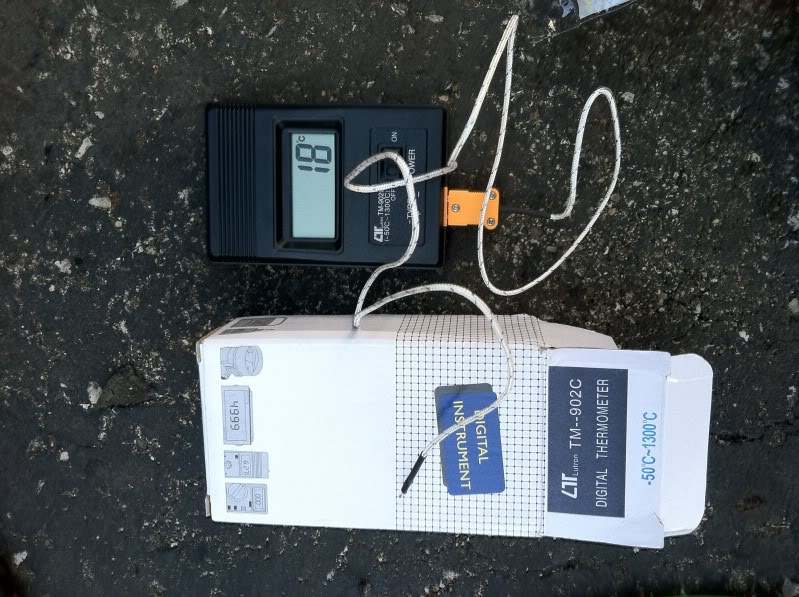 Next I looked for a way to install the tiny probe as close to one of the brake pads as possible. After studying the caliper, found a very small gap between the back of the outboard pad and the caliper - just big enough to squeeze the probe in and wrap the lead wire around the caliper, between the cooling fins, and around the banjo screw. Then the lead wire is simply routed along with the brake hose into the engine compartment.
WARNING: DON'T TRY THIS UNLESS YOU ARE WILLING TO ACCEPT ANY/ALL RISK ASSOCIATED WITH INSTALLING A WIRE NEAR ROTATING PARTS & UNSPRUNG MASS. THIS IS MEANT FOR EXPERIMENTAL TESTING PURPOSES - NOT FOR PERMANENT INSTALLATION.
Probe installation:  Lead wire routing:  The lead wire that came with the meter is not nearly long enough to reach the cabin, so I soldered another 6 feet of thin wire to the lead conductors. To do this, the plug needed to be removed from the original lead conductors: 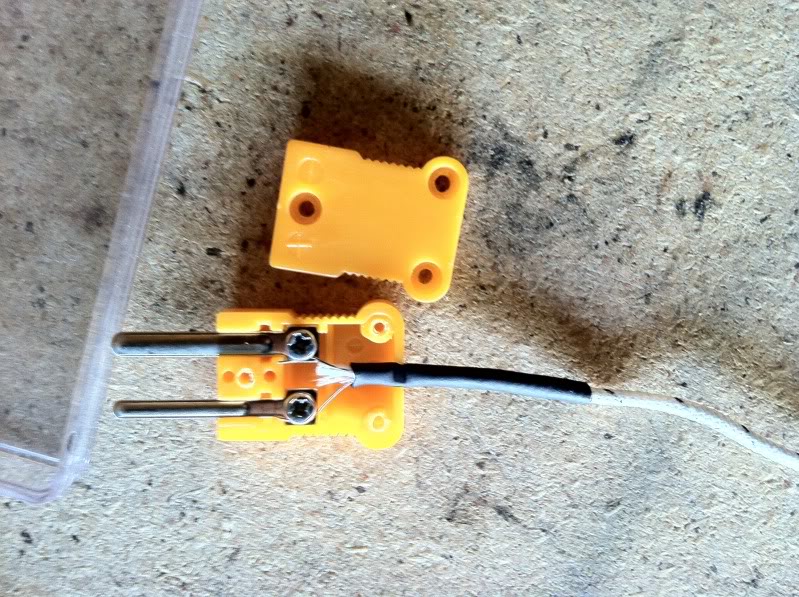 And reattached to the new wires:  Here's the soldered joint with heat shrink:  With the hard part out of the way, the lengthened wire was snaked up over the fender, beside the strut tower, and through the door jamb. I used duct tape to mount the display to the windshield, near the dash. Instant ghettofabulous brake temp gauge. As I went on my first test drive to break in the new rotors, it became clear that the numbers being displayed were in fact actual real-time temperature readings from the outboard pad. Values changed near instantly when I applied the pedal. By that, I mean the numbers started climbing within 1-2 seconds of initiating the braking event. At higher speeds and hotter temps, it is near instant. I could tell right away there was potential fun to be had with this. Note: graphs shown below were produced from memory, with the help of a video camera to help record the event behaviors. Temperatures are approximate, and time durations are simplified for the sake of presentation. Please don't assume the graphs are literally 100% accurate. Their purpose is to show the general behavior of brake pad temperature vs. pedal application, factoring in vehicle speed and time.Discovery #1: brakes are warmer than ambient most of the time, or at least during the day. The sunlight heats up the wheels, rotors, and calipers. On a 65ºF day, I was surprised to see the brake pads were reading about 95ºF ambient in the sun. Discovery #2: moving air does in fact cool the rotors, calipers, and pads at speed, but not too effectively. The faster you cruise, the better the cooling effect, however, it takes a long time and pretty high speeds to bring the calipers close to ambient. On a 120 mile trip, averaging about 80 mph, it took about half an hour to get the reading to 80ºF, and it would go no lower. 67ºF ambient on this day. Discovery #3: brake pad temperatures are a lesson in thermodynamics and entropy. My findings were not as expected, and I still don't understand everything I'm seeing. One thing I found to be fairly predictable: a strong, brief braking event results in a "blip" of heat from the pad, where temperature rises and falls abruptly. If the car comes to a complete stop, the pad temperature will fall more slowly, or "recover" until close to ambient (or ambient in the sun). My take on what's happening - the pad gets hot, transferring heat to the caliper and rotor, warming both. After the event, the pad cools rapidly until it reaches the temperature of the caliper. This is the blip. After that, it cools with the caliper, which occurs at a slower rate. This is the recovery. This graph shows "blip" and "recovery": 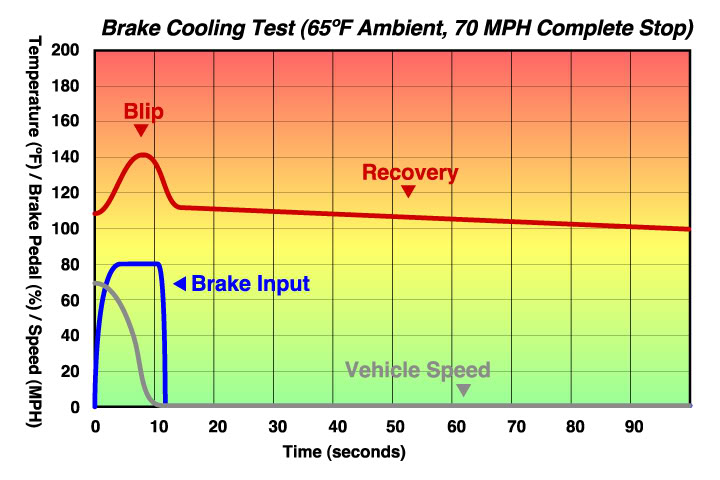 Discovery #4: for some reason, if the vehicle remains rolling after the braking event, the blip is followed by an "echo", and then the recovery. I really have no idea why this is, but it happens whether the wheels are rolling very slow, or very fast, and it's very consistent. But there is little or no echo if the vehicle comes to a stop. Any ideas? I'm all ears. Here's the graph showing "echo": 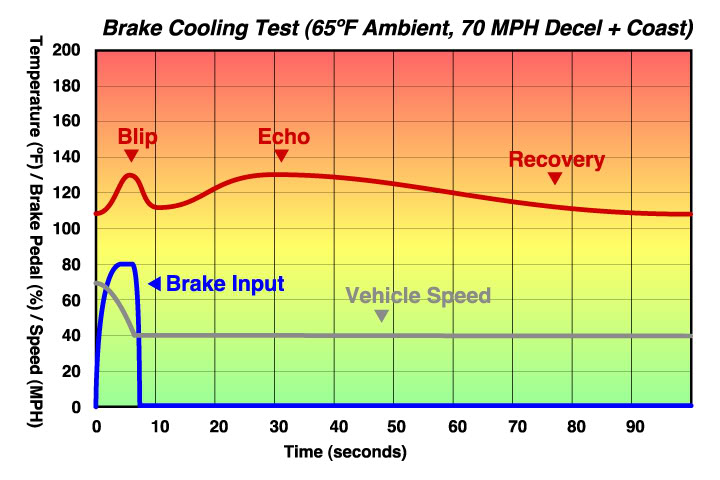 This one shows a delayed echo after a short stop (brief recovery):  Discovery #5: consecutive, equal decelerations, followed by consecutive equal accelerations results in a linear increase in brake pad temperature. This was pretty easy to guess, considering the previous discoveries. 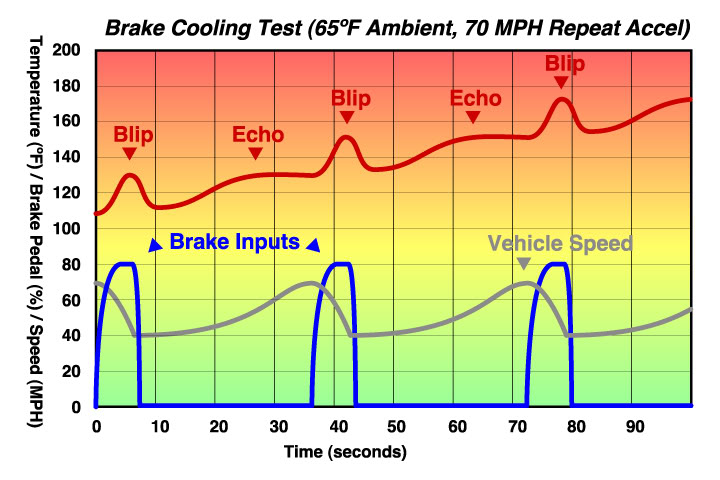 Discovery #6: consecutive events of equal brake pedal pressure, for longer periods of time, combined with increased accelerations (increasing speed) results in a non-linear increase in brake pad temperature. Also not hard to predict this one. 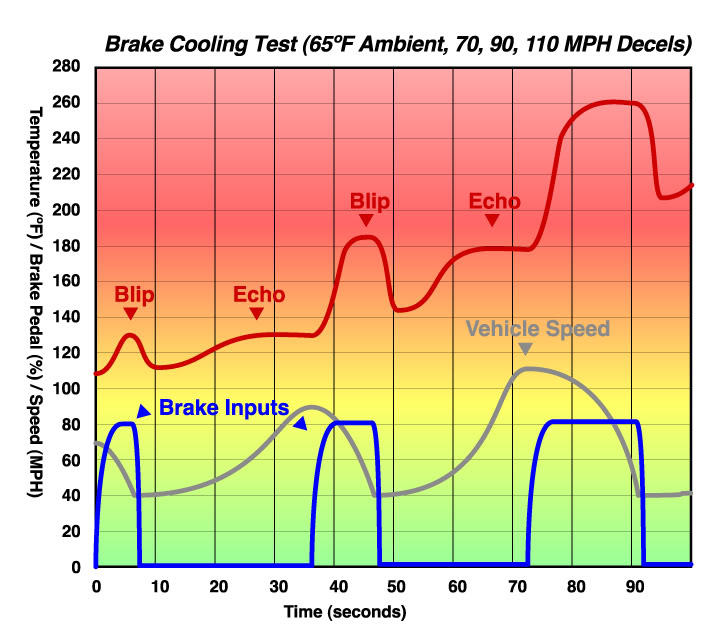 Discovery #7: consecutive events of decreasing brake pressure, for equal periods of time, combined with zero acceleration (decreasing speed) results in the same non-linear increase in brake pad temperature. This one really caught me by surprise, but it makes perfect sense. As you slow to lesser speed, the air cooling effect is decreased, and the brakes get hotter and hotter. It's especially true if you are slowing from a high speed with already warm brakes. Of all the tests I performed, this one got my pads the hottest - up to 400ºF after a few minutes of frequent braking at low speed!!! 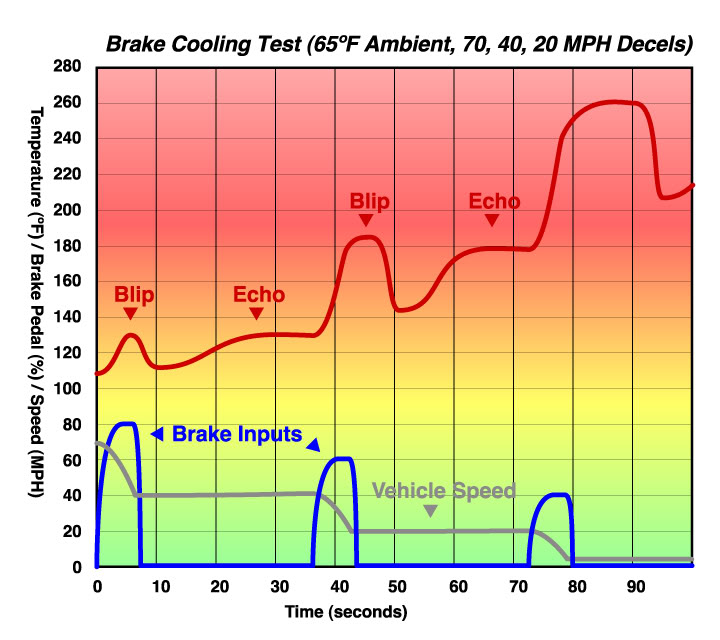 That's all for now. Hope this is interesting for some. I plan to monitor for a while longer, and will try a few more scenarios and record results. So far, it seems that while air cooling already plays a significant role with brake temps, it could be improved. Not sure how far I want to take this, but I'll probably end up mocking up at least one test-mule and mounting it to the control arm, just to see if there is any change. _________________ '05 GTO 6.0L • 6-spd • 95k miles • 0-60: 4.8s • 16.9 avg MPG • Nelson Ledges Lap: 1:26'95 Celica GT 2.2L • 5-spd • 165k miles • 0-60: yes'98 SC Riviera • 281k miles • 298 HP/370 TQ • 0-60: 5.79s • ET: 13.97 @ 99.28 • 4087 lb • 20.1 avg MPG • Nelson Ledges Lap: 1:30
3.4" pulley • AL104 plugs • 180º t-stat • FWI w/K&N • 1.9:1 rockers • OR pushrods • LS6 valve springs • SLP headers • ZZP fuel rails
KYB GR2 struts • MaxAir shocks • Addco sway bars • UMI bushings • GM STB • Enkei 18" EV5s w/ Dunlop DZ101s • F-body calipers
EBC bluestuff/Hawk HP plus • SS lines • Brembo slotted discs • DHP tuned • Aeroforce • Hidden Hitch^^^ SOLD ^^^  '70 Ninety-Eight Holiday Coupe 455cid • 116k miles '70 Ninety-Eight Holiday Coupe 455cid • 116k miles^^^ SOLD ^^^  | |
|   | | Jason
Aficionado

Name : Jason
Age : 40
Location : Comox, BC, Canada
Joined : 2007-01-23
Post Count : 1378
Merit : 65
 |  Subject: Re: Brake Cooling Options Subject: Re: Brake Cooling Options  Wed Apr 11, 2012 11:33 am Wed Apr 11, 2012 11:33 am | |
| | |
|   | | Karma
Aficionado

Name : Andrew
Age : 39
Location : Ontario, Canada
Joined : 2008-01-14
Post Count : 1949
Merit : 123
 |  Subject: Re: Brake Cooling Options Subject: Re: Brake Cooling Options  Wed Apr 11, 2012 1:38 pm Wed Apr 11, 2012 1:38 pm | |
| I'm going to guess the echo is because the rotating disk and surface area of the disk provides the best escape for the heat into the air as opposed to the caliper. Your sensor is in the caliper and under the braking event whilst heating is still undergoing a good amount of thermal transfer to the rotor which is transferring the heat to the air more effectively. When you brake to a stop that transfer continues to happen. When braking and then letting off, both the rotor and pad build up significant heat, but on release the pad/caliper sheds its heat slower, and in turn absorbs the heat dissipating from the rotor as it attempts to do so. Picture two cups of water with the same amount of water(heat) in them. Joined together they gain and lose water(heat) at the same rate. But removed from each other; one looses water(heat) slower, and the other sprays its water(heat) everywhere with some of its ending up back in the other cup(pad/caliper). This second cup must then process again water(heat) that the other has already shed. Hense the echo.
But that's really just a guess.
Neat tests though. I've often though that a back shroud and cooling duct could really improve cooling our brakes. Especially the rear ones that already has a metal back bit that could get a hole put in it and ducted up. _________________  | |
|   | | AA
Administrator

Name : Aaron
Age : 46
Location : C-bus, Ohio
Joined : 2007-01-13
Post Count : 18448
Merit : 252
 |  Subject: Re: Brake Cooling Options Subject: Re: Brake Cooling Options  Wed Apr 11, 2012 2:05 pm Wed Apr 11, 2012 2:05 pm | |
| Interesting theory. It makes sense, except I have a habit of shifting into N and coasting to a complete stop without the brake applied, so the pad face doesn't actually touch the rotor face when the car is idle. The only difference is the rotor isn't moving, and I'd think that would cause the pad to retain heat, not transfer.
Good idea, though. I'll double check the behavior, testing stops both with and without brakes applied.
Rear brake cooling would be really easy to do, but I wonder if necessary? _________________ '05 GTO 6.0L • 6-spd • 95k miles • 0-60: 4.8s • 16.9 avg MPG • Nelson Ledges Lap: 1:26'95 Celica GT 2.2L • 5-spd • 165k miles • 0-60: yes'98 SC Riviera • 281k miles • 298 HP/370 TQ • 0-60: 5.79s • ET: 13.97 @ 99.28 • 4087 lb • 20.1 avg MPG • Nelson Ledges Lap: 1:30
3.4" pulley • AL104 plugs • 180º t-stat • FWI w/K&N • 1.9:1 rockers • OR pushrods • LS6 valve springs • SLP headers • ZZP fuel rails
KYB GR2 struts • MaxAir shocks • Addco sway bars • UMI bushings • GM STB • Enkei 18" EV5s w/ Dunlop DZ101s • F-body calipers
EBC bluestuff/Hawk HP plus • SS lines • Brembo slotted discs • DHP tuned • Aeroforce • Hidden Hitch^^^ SOLD ^^^  '70 Ninety-Eight Holiday Coupe 455cid • 116k miles '70 Ninety-Eight Holiday Coupe 455cid • 116k miles^^^ SOLD ^^^  | |
|   | | AA
Administrator

Name : Aaron
Age : 46
Location : C-bus, Ohio
Joined : 2007-01-13
Post Count : 18448
Merit : 252
 |  Subject: Re: Brake Cooling Options Subject: Re: Brake Cooling Options  Mon Sep 23, 2013 8:05 pm Mon Sep 23, 2013 8:05 pm | |
| Digging up this thread for a quick addition. From the intake ideas thread, it should be possible to remove the turn signal lenses and use the existing bumper ducts for brake cooling. Turn signal function would be restored by rewiring the headlamp corners to flash (removing signal illumination feature). A length of flexible silicone hose would be added behind each duct and routed through the fender linings to each hub area. Thanks to charlieRobinson for the idea! _________________ '05 GTO 6.0L • 6-spd • 95k miles • 0-60: 4.8s • 16.9 avg MPG • Nelson Ledges Lap: 1:26'95 Celica GT 2.2L • 5-spd • 165k miles • 0-60: yes'98 SC Riviera • 281k miles • 298 HP/370 TQ • 0-60: 5.79s • ET: 13.97 @ 99.28 • 4087 lb • 20.1 avg MPG • Nelson Ledges Lap: 1:30
3.4" pulley • AL104 plugs • 180º t-stat • FWI w/K&N • 1.9:1 rockers • OR pushrods • LS6 valve springs • SLP headers • ZZP fuel rails
KYB GR2 struts • MaxAir shocks • Addco sway bars • UMI bushings • GM STB • Enkei 18" EV5s w/ Dunlop DZ101s • F-body calipers
EBC bluestuff/Hawk HP plus • SS lines • Brembo slotted discs • DHP tuned • Aeroforce • Hidden Hitch^^^ SOLD ^^^  '70 Ninety-Eight Holiday Coupe 455cid • 116k miles '70 Ninety-Eight Holiday Coupe 455cid • 116k miles^^^ SOLD ^^^ 
Last edited by AA on Mon Sep 23, 2013 11:47 pm; edited 1 time in total | |
|   | | charlieRobinson
Expert

Name : Charlie
Age : 38
Location : Toledo, OH
Joined : 2011-05-17
Post Count : 3922
Merit : 31
 |  Subject: Re: Brake Cooling Options Subject: Re: Brake Cooling Options  Mon Sep 23, 2013 10:27 pm Mon Sep 23, 2013 10:27 pm | |
| It's ROBINSON, bro. Parker was a drug head saxophoner. Robinson is my dog. My dog is also a drug head saxophoner. | |
|   | | AA
Administrator

Name : Aaron
Age : 46
Location : C-bus, Ohio
Joined : 2007-01-13
Post Count : 18448
Merit : 252
 |  Subject: Re: Brake Cooling Options Subject: Re: Brake Cooling Options  Mon Sep 23, 2013 11:47 pm Mon Sep 23, 2013 11:47 pm | |
| Sorry charlie. Keying a little too fast while a little too tired! _________________ '05 GTO 6.0L • 6-spd • 95k miles • 0-60: 4.8s • 16.9 avg MPG • Nelson Ledges Lap: 1:26'95 Celica GT 2.2L • 5-spd • 165k miles • 0-60: yes'98 SC Riviera • 281k miles • 298 HP/370 TQ • 0-60: 5.79s • ET: 13.97 @ 99.28 • 4087 lb • 20.1 avg MPG • Nelson Ledges Lap: 1:30
3.4" pulley • AL104 plugs • 180º t-stat • FWI w/K&N • 1.9:1 rockers • OR pushrods • LS6 valve springs • SLP headers • ZZP fuel rails
KYB GR2 struts • MaxAir shocks • Addco sway bars • UMI bushings • GM STB • Enkei 18" EV5s w/ Dunlop DZ101s • F-body calipers
EBC bluestuff/Hawk HP plus • SS lines • Brembo slotted discs • DHP tuned • Aeroforce • Hidden Hitch^^^ SOLD ^^^  '70 Ninety-Eight Holiday Coupe 455cid • 116k miles '70 Ninety-Eight Holiday Coupe 455cid • 116k miles^^^ SOLD ^^^  | |
|   | | Sponsored content
 |  Subject: Re: Brake Cooling Options Subject: Re: Brake Cooling Options  | |
| |
|   | | | | Brake Cooling Options |  |
|
Similar topics |  |
|
| | Permissions in this forum: | You cannot reply to topics in this forum
| |
| |
| |
|









